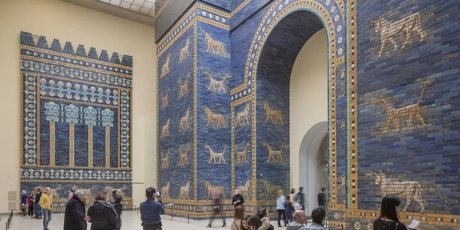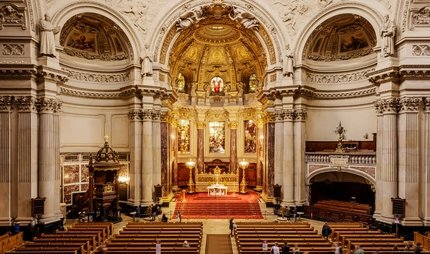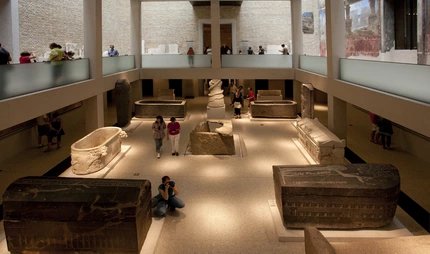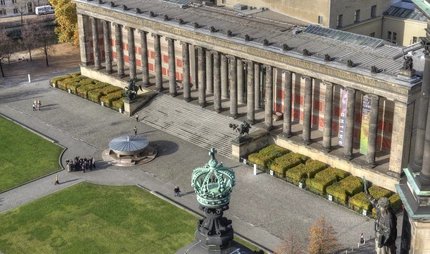
The Vorderasiatische Museum
The Museum of the Ancient Near East in the Pergamonmuseum is closed for extensive refurbishment
Please note: The Pergamon Museum, and thus also the Museum of the Ancient Near East in the Pergamonmuseum, has been closed since October 2023 for extensive renovation.
Babylonia, Assyria and Sumer - the Vorderasiatisches Museum takes you on a voyage through avenues and temples from rich cultures. The collection includes small objects; clay tablets, pieces of jewellery, vessels, reconstructions of magnificent buildings and throne rooms with original facades. Highlights are the blue glazed Ishtar Gate, one of the Babylonian city gates. This exhibition of the Middle East is a leader in its kind. You can find it in the Pergamon Museum, one of Berlin's national museums on Museum Island.
Ancient treasures from the Orient
The second half of the 19th century is a great moment in archaeological history. Excavation fever leads many German researchers to travel to the Middle East, discovering numerous stone witnesses to the past and bringing them to Berlin. In 1899, a separate collection of art from the Middle East is founded to house the treasures. Initially, the collection is part of today's Bode-Museum but has found its permanent home in the Pergamon Museum from 1929. Since 1999, it has been part of the UNESCO World Heritage site of Museum Island. The monumental architecture of the Pergamon Museum is typical of the Wilhelminian era. Over 35 metres wide, the Pergamon's pediment, which will be renovated until 2027, is the pièce de résistance. Behind the facade, to the left, you find the Vorderasiatisches Museum. 14 rooms with an area of 2,000 square metres stretch out before you. High, white walls dominate, creating an ambience of grandeur. On these walls, Oriental artworks appear in great contrast. Walk through a reconstructed Babylonian processional way to the authoritative Ishtar Gate. The blue tiled walls with their animal paintings conjure up the rest of the former fortifications. In addition to this central exhibit, you can see fragments of the Temple of Inanna of Uruk. The detailed reliefs on the facade are worth noting. Many of the exhibits are replicas and casts of originals; the Oriental animal sculptures, for example. The museum displays jewellery, religious artefacts and legal documents in cuneiform script. In total, the collection spans over 6,000 years of art and cultural history.
Highlights of the exhibition
- Blue-tiled Ishtar Gate with animal motifs from Babylon.
- Necklace from Assyrian tomb in the 14th century BC.
- Sculpture of a Mesopotamian God.
- Reconstruction of a new Assyrian Palace room with Alabaster reliefs.
- Clay tablets with ancient cuneiform scripture.
Explore the Museum Island
On Museum Island, you will find the most important historical collections in Berlin. The architecture of the Altes Museum is worth a visit in itself. The entrance is a rotunda, reminiscent of the Roman pantheon, lined with Corinthian columns. The collection features works of art from the Roman and Etruscan periods. Neues Museum is the work of architect Friedrich August Stüler. Here, The Egyptian court is especially beautiful with its painted columns. Another highlight is the world famous Nefertiti bust housed within the Neues Museum's Egyptian Museum. The Museum of Prehistory and Early History holds the treasure of Priam's Troy, excavated by Schliemann.
Our tips for your visit
Take the U5 and get off at the "Museumsinsel" station. The Vorderasiatisches Museum is just a few minutes' walk from Friedrichstraße and Hackescher Markt stations. Underground line U6 and the S-Bahn lines S1, S2, S25, S5, S7 and S75 stop here. Alternatively, take the M1 and 12 trams to Kupfergraben station. Buses 100 and 200 stop at the Lustgarten nearby.
Opening hours
| Tuesday | |
|---|---|
| Wednesday | |
| Thursday | |
| Friday | |
| Saturday | |
| Sunday |



